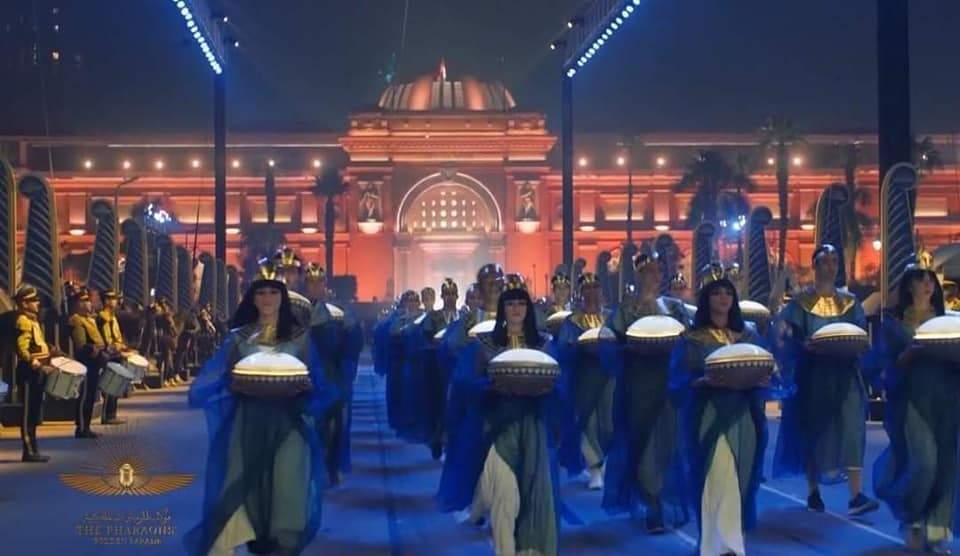Pharaonic Trash. Egypt moves 22 mummies in superkitsch parade
A spectacle somewhere between a military regime parade and a highly plastic Hollywood blockbuster: that could be summed up as the “Golden Parade of the Pharaohs,” the pompous showEgypt put on yesterday to transport twenty-two mummies (of eighteen pharaohs and four queens) from the Egyptian Museum in Cairo’s Tahrir Square to the National Museum of Egyptian Civilization on the outskirts of the capital. These are mummies found in Luxor in two expeditions (one in 1881 and one in 1898), all dating from the New Kingdom era (1539 to 1075 B.C.): the mummies include those of Rameses II, Queen Hatshepsut, and King Seqenenre. The pharaohs’ bodies will now be displayed in the new wing of the National Museum, which opens to the public on April 18.
The mummies were loaded onto twenty-two pickup trucks, converted for the occasion into special golden parade floats (Egypt assures that they were designed to absorb the roughness of the road: they had to traverse a five-kilometer route), and accompanied by a costumed procession that was more reminiscent of Totò vs. Maciste than the reign of the pharaohs, complete with Las Vegas hotel-style lights and scenery reminiscent of the Egyptian pavilion at the 2019 Venice Biennale (in the opinion of many the worst, by far, of the event): a jumble of fanfares, soldiers on horseback, marching bands, bidders disguised as ancient Egyptians, flags and assorted kitsch to escort the entrance of the mummies into the new display cases of the Royal Mummies Hall (also decorated to resemble the Valley of the Kings).
“It’s exciting, everyone will watch it,” archaeologist-star Zahi Hawass, a former minister of antiquities who is very popular in the country, had commented before the show. Everyone except many Egyptians, as Mona El-Naggar wrote in the New York Times: in fact, along the route are some of the city’s working-class neighborhoods, which were well hidden from view (with mega-screens, Egyptian flags, lights and huge scaffolding) in the broadcast that accompanied the event (designed specifically to be aired on TV), “a reminder of the stark contrast between Egypt’s celebrated past and its uncertain present,” El-Naggar writes. And no residents of the neighborhoods were allowed to leave their homes or even go down to the street to see the show, reports the New York Times: they were only allowed to watch it on screen.
And indeed, the trashy parade, which began with a cannon salute and was strongly desired by Egyptian President Abdel Fattah al-Sisi, was intended more for foreign countries than for Egyptians, as it was meant to be an incentive to bring tourists back to the country after the Covid-19 pandemic, but appeared more like a show to celebrate his dictatorship, as Quotidiano also points out. net, not least because, after images of the mummies with names and hieroglyphs were broadcast on the mega-screens set up for the occasion, viewers on site and connected to world television watched a roundup of the public works “desired and inaugurated by His Excellency the President” in recent years, including the much-criticized transformation of Tahrir Square where four sphinxes were moved from Luxor last year, amid a thousand protests, to be placed in the middle of a traffic circle. And patience for the worldwide debacle of the Suez Canal blockade that kept shipping traffic halfway across the planet at a standstill for a week.
But patience, too, for Egypt’s less-than-stellar performance, recalled by the Manifesto in its article on “Pharaos’ Golden Parade.” 30 percent of Egyptians live below the poverty line, another 30 percent just above; subsidies for basic necessities have seen major cuts by the regime, which in the meantime has tripled military spending in ten years; and then again, the proposal to charge the population for anti-Covid vaccines (10 euros per dose in a country where the average salary is about 317 euros per month); buildings collapsing because there is a lack of resources for maintenance. Not to mention the summary justice exercised in the country (it will be worth mentioning how Patrick Zaki is still held “hostage,” to use Amnesty’s term, by the regime in its prisons, and how Egypt continues to be opaque on the Giulio Regeni affair).
 |
| Pharaos’s Golden Parade |
 |
| Pharaos’s Golden Parade |
 |
| Pharaos’s Golden Parade |
 |
| Pharaonic Trash. Egypt moves 22 mummies in superkitsch parade |
Warning: the translation into English of the original Italian article was created using automatic tools. We undertake to review all articles, but we do not guarantee the total absence of inaccuracies in the translation due to the program. You can find the original by clicking on the ITA button. If you find any mistake,please contact us.





























